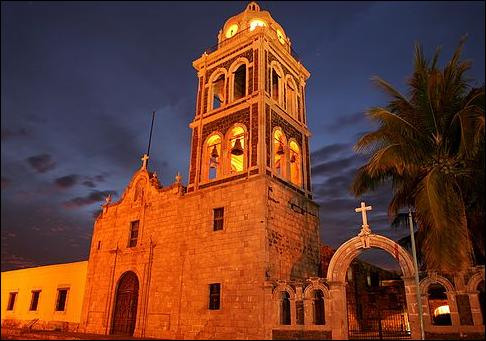January 28, 2007
As I mentioned in a previous article, Loreto was the capital of both Californias about 240 years ago (the current Mexican State of Baja California and the current U.S. State of California).
Loreto was also the location where one of the first Spanish missions was built. Here's more info:

The current church of Loreto where it all started and where the first Spanish mission was built
Mission Loreto was founded on October 25, 1697 at the Monqui settlement of Conchó in the present city of Loreto, Baja California Sur, Mexico. Established by the Jesuit missionary Juan María de Salvatierra, this earliest successful mission in Baja California is sometimes considered "head and mother of all the Spanish missions in Upper and Lower California".[...] On October 19, 1697, Salvatierra, with a small group of soldiers, disembarked from the galley "Santa Elvira" in the Bay of San Dionisio at 26° N latitude. In the first days after their arrival, the missionary erected a modest structure that served as a chapel, to the front of which they affixed a wooden cross. On October 25 they carried the image of the Virgin of Our Lady of Loreto in a solemn procession, a ritual of faith that claimed the area as Spanish territory. Thus began the mission.
Loreto served as the base for further expansion of the Jesuit mission system, first in south-central Baja California and then to more remote portions of the peninsula both to the north and to the south. The mission's stone church, which still stands, was begun in 1740. Loreto continued to be the headquarters even after the Jesuits were expelled from Baja California and replaced, first by the Franciscans in 1768 and then by the Dominicans in 1773.
The mission came to an end in 1829, by which time the native Indian neophyte population throughout Baja California Sur had become extinct.
You can visit the current church in downtown Loreto and there's even a small museum. This is pretty amazing: this building is over 300 years old and the place where it all started for both Californias.
I copy more information on the "Misión de Nuestra Señora de Loreto" below.
Misión de Nuestra Señora de Loreto Conchó
From Wikipedia, the free encyclopedia, Link
Mission Loreto was founded on October 25, 1697 at the Monqui settlement of Conchó in the present city of Loreto, Baja California Sur, Mexico. Established by the Jesuit missionary Juan María de Salvatierra, this earliest successful mission in Baja California is sometimes considered "head and mother of all the Spanish missions in Upper and Lower California."
After Hernán Cortés' initial failed 1535 attempt to found a colony in the Bay of Santa Cruz (today's La Paz, Baja California Sur), the next 150 years were marked with further unsuccessful efforts to colonize Baja California. The most nearly successful of these attempts was the 1683-1685 outpost at San Bruno, only about 20 kilometers north of Loreto, among the Cochimí. This failure by Admiral Isidro de Atondo y Antillón and the Jesuit missionary Eusebio Francisco Kino led directly to the success at Loreto 12 years later.
After many unsuccessful ventures in Baja California, the government of New Spain and the Spanish crown were reluctant to finance any further attempts. However, Kino's enthusiasm for this potential mission field was persistent. He ultimately persuaded some of his colleagues, including Salvatierra, and the authorities in New Spain to allow the Jesuits to return to the peninsula, but this time on their own responsibility and largely at their own expense.
By the start of 1697 everything was ready for the journey's start at the mouth of the Río Yaqui River in Sonora. Kino was unable to participate, because an Indian rebellion in Sonora required his presence on the mainland. Salvatierra would soon be joined at Loreto by Francisco María Piccolo, and they were supported from the mainland by the procurador for the mission, Juan de Ugarte.
On October 19, 1697, Salvatierra, with a small group of soldiers, disembarked from the galley "Santa Elvira" in the Bay of San Dionisio at 26° N latitude. In the first days after their arrival, the missionary erected a modest structure that served as a chapel, to the front of which they affixed a wooden cross. On October 25 they carried the image of the Virgin of Our Lady of Loreto in a solemn procession, a ritual of faith that claimed the area as Spanish territory. Thus began the mission.
Loreto served as the base for further expansion of the Jesuit mission system, first in south-central Baja California and then to more remote portions of the peninsula both to the north and to the south. The mission's stone church, which still stands, was begun in 1740. Loreto continued to be the headquarters even after the Jesuits were expelled from Baja California and replaced, first by the Franciscans in 1768 and then by the Dominicans in 1773.
The mission came to an end in 1829, by which time the native Indian neophyte population throughout Baja California Sur had become extinct.
See also:
Spanish missions in California
http://en.wikipedia.org/wiki/Spanish_missions_in_California
Spanish colonization of the Americas
http://en.wikipedia.org/wiki/Spanish_colonization_of_the_Americas